A single metal pot sits on the stand-alone gas burner. The chef stirs her mohinga, a Burmese stew of fish, garlic, onions, ginger, and lemongrass, keeping it hot but not burning through the whole morning. She ladles it out over bowls of rice noodles, topping each with cilantro, fried shallots, green onions, and crispy lentil crackers. Each bowl goes to a regular customer or a foodie pilgrim who’s woken up early to get to her stall before she runs out, as she does every week. It’s a single metal pot for the whole city.
This one stand at the Friday morning market is the only place in Chiang Mai I know of to get this classic dish from Myanmar. There may be plenty of Burmese and other folks in the city cooking the salty-but-slightly-sour rice noodle stew at home. But as a foreigner trying to know this place, this woman’s stand is one little way to treasure the immense diversity of northern Thailand.
Northern Thailand has its own culture, distinct from that of central, southern or northeastern Thailand. Chiang Mai traces its roots to the Lanna Kingdom, a civilization that stretched across northern Thailand and rivaled the Ayutthaya Kingdom in the 15th century. But the region is also the home of an immense diversity of peoples and cultures that are not strictly Thai – Burmese, Karen, Hmong, Shan, Lisu, Lahu, Akha, Palaung, and Yao, to name some. Like the Lanna culture, each has their own language. Many live in their own separate communities in rural areas but most are also a part of integrated towns and cities. Many people from these groups may also consider themselves to be Thai.
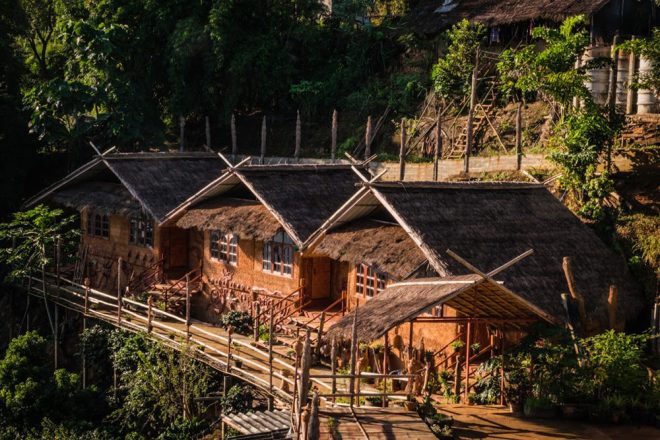
These groups offer a more complete picture of northern Thailand, with their own indigenous traditions, lifestyles, and histories. But many of the ways that travelers try to interact with these ethnic groups can be exploitative. Some tours and “attractions” deny these communities the right to decide how, when, and whether they want to share their lives and cultures with outsiders.
It’s not really my place as a white foreigner to tell any stories of northern Thailand’s diverse culture. But Chiang Mai guesthouses and songtaews are covered with advertisements for tours of hill tribe villages, and I’d like to at least point people in the direction of a counter-narrative.
Most ads show the “long-neck Karen” or Kayan, a culture in which the women traditionally wear brass coils around their necks. Tourists sign up for these or other “ethnic minority tours” and complain of being taken to meet groups of women who appear miserable and try aggressively to sell their handicrafts. Travelers take tours to “authentic tribal villages” that they wincingly describe, after the fact, as “human zoos.” These tours don’t give the communities much of a chance to teach what they have to offer, should they even want to, and travelers are looking for a better option.
This sort of tourism isn’t new in Thailand. According to Thailand’s Ministry of Culture, tours of long-neck Kayan villages have been going on since 1985. When some of the women who wore coils were accepted for resettlement by New Zealand, Thai officials reportedly refused to let them leave because they would damage the area’s tourism potential.
The debate about these tours is well-documented online, complete with travel bloggers’ inner qualms and recommendations (here, here, here, here, and here) and coverage of good-sounding responsible tourism projects (here, here). These are worth reading.
I’m not an arbiter of any sort in this debate. The diversity of northern Thailand is deeper and more valuable than I know and, as with most questions about ethical tourism, it’s best to leave it up to the locals involved.
Visiting ethnic minority villages that are off the standard tourist path is often marked by a power imbalance, at least in terms of money and some aspects of agency. The tourist is opting in to the experience, whereas members of the community may not have much say in the interaction.
It’s on us as travelers to look for unmediated, direct interactions with members of these communities and use our judgement to decide if they want to share their space with us. Where we have someone facilitate our interaction, we need to trust their intentions and priorities.
I learn more from other cultures when I interact with them on their own terms, in situations where they are in control – as much as possible. If a community doesn’t want to share their lives and culture with travelers, then trying to learn from them can be extractive. We take their time and energy when we ask these groups to share with us. If they’ve decided it isn’t beneficial to teach visitors about their lives, we’re taking something away while giving nothing in return.
Consider who else holds what kind of power in the situation – we hold a lot, but are their tour operators involved? Who else is making money or otherwise benefiting and are they a part of the community you’re visiting?
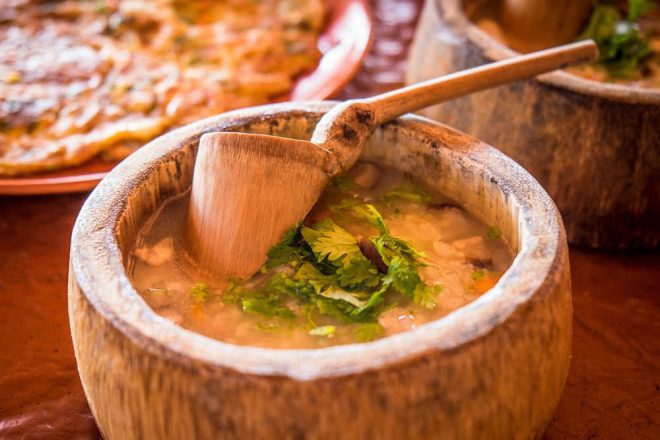
Eating mohinga is in some ways a simple act of appreciation. All I did was buy soup, yet there’s still a history and a broader meaning and it only gets more complicated from here. But that’s the point: to consider our position in the world and how the people we encounter shift the ground around us.
The recommendations here are opportunities to learn about the cultures and lifestyles of northern Thailand’s diverse ethnic groups – some indigenous and some not – in situations where they welcome the respectful interest of outsiders. All are setup to reinvest your dollars directly into the community you’re interacting with.
A note on word choice: The Thai government, tour agencies, travelers, and members of the groups often refer to them as “hill tribes.” The label sounds better in Thai – khon doi or chao khao – and one literal translation of it, “mountain people,” even seems benign. But to me, the term “hill tribes” increases the distance between folks like me and the people I hope to learn from and about. I’m not confident on this but for now, I use the comfortable, politically correct, fairly all-inclusive term “ethnic groups.” I don’t claim to be “right” in any sense. Do as you will, or, preferably, ask the people we’re talking about if you meet them.
Where to Learn About the Many Cultures Inside Chiang Mai
Ina House
If you’re looking for a place to stay in Chiang Mai and a source for recommendations, Ina House should be your first stop. This guesthouse is a non-profit project run by the Asia Indigenous Peoples Pact (AIPP) and the staff are a great resource. They can suggest opportunities to learn about ethnic groups in the area and the issues they face. The mission of Ina House is to raise awareness about the need to preserve and respect indigenous cultures and ways of life.
Located on the east bank of the Ping River in the middle of the city, it’s a great location for any stay in Chiang Mai. Their restaurant also serves traditional indigenous dishes and can tailor them for vegans and vegetarians.
Also take a look at the Hill Tribes Museum in Chiang Mai, but do double-check whatever you learn with someone from the ethnic groups themselves.
The Friday Morning Market
This is where the woman with the mohinga sets up her burner and pot. The market is known by many names and this speaks to the wide diversity of the place: the Chin Haw market, the Burmese Market, the Chinese Market, the Muslim Market. They’re all the same place, in front of the mosque at the north end of the Night Bazaar. Vendors sell dishes from Burmese, Shan, Chinese, and Muslim cultures. They’ve got blue chickens, regular-colored chickens, spicy shrimp curries, fermented tofu (“Chinese cheese”), Halal goat yogurt, corn dumplings, and everything you need to stock a Burmese, Shan or Yunnan Chinese kitchen.
It’s a chance to get acquainted with some of this food ask whatever questions you might have, especially if you can go with a guide or find someone who’s happy to speak English. Most of the vendors will be happy to chat briefly. An independent study abroad group in Chiang Mai, ISDSI (the International Sustainable Development Studies Institute), sends students here to talk with vendors and local clientele about the market, why it exists, and what it means to them. Note that not everyone here speaks Thai – I posed a question in Thai to some older women spending their morning over glasses of tea and got a laughing stream of Mandarin in return.
To find the mohinga, walk south from the mosque through the entrance for about 100 meters. You’ll have to weave around a bit but once you’re in a covered walkway with vegetable sellers on either side, look to your left (the east side). Also, just ask someone where the mohinga is and see if you can get into an exchange about the market and their place in it all.
Beyond the mohinga, the highlight for breakfast is the Shan culture’s tofu nway, a yellow chickpea porridge dish served with a whole mix of sauces and some combination of pork, noodles, spicy pickles, peanuts, and sesame. I’ve tried to live solely on this stuff before. Most of the vendors in the food court-type area are serving it. Also look for stands serving noodle salads with tomato, pork, peanuts, and green onions, as well as the one vendor dishing up rainbow-colored rice, naan, samosas and the like. For a smaller snack, look for sellers cooking black sticky rice pancakes on the grill.
The market runs from about 6 AM – 11 AM every Friday.
Also look for Burmese food at The Swan or Burmese Library (there’s no library involved, sadly). For Shan food, try this local market north of Chiang Mai University on Mondays 3-7 PM or the whole-in-the-wall shops on this little soi above the northeast corner of the Old City.
Akha Ama
There’s plenty of sustainably-sourced coffee in Chiang Mai, but Akha Ama Coffee is a chance to learn about the Akha ethnic group through a cup of coffee, or preferably a tour of their coffee farms. The company was founded by a member of an Akha community near Chiang Mai, Ayu “Lee” Chuepa, who was looking to improve his life and that of his neighbors. To get a sense of Akha Ama and Lee’s journey, watch his TED Talk. They work with a network of families to produce over 25 tons of coffee per year and train Akha youth to work as Baristas. They’ve opened two locations – one northwest of the old city in Santitham and one in the center, near Wat Phra Singh. The coffee has now won international awards and the founder partners with Stumptown Coffee in Portland. They’re in Vice too. If you’d like to do more than just come in for a cup of coffee, contact them in advance.
Outside of Chiang Mai: Chances to Get to Know the Karen, Akha, and Yunnanese People
Ban Nong Tao
The indigenous Karen Village of Ban Nong Tao sits at the top of the Mae Wang river valley. A mountain road begins with rows of elephant camps and restaurants on the Mae Wang river before stretching up into more evergreen forests above. The Karen in Ban Nong Tao have been struggling for the right to continue their indigenous ways of life – new nature conservation laws have criminalized their traditional forestry and farming techniques, and the community is working with Karen and other ethnic groups across Thailand to push back against these threats.
The community in Ban Nong Tao wants visitors to understand the issues they face and their indigenous way of life. They’re open about their way of life: their religious traditions that combine Christianity and indigenous beliefs, the complexities of educating their kids, and the importance of their cultural legends and stories. Jorni Odochao, a community leader, and his sons Prue and Siwakorn regular talk with visitors to the village – educational and civil society groups, mostly.
Prue once walked over 700 km to Bangkok to call for a new land law to protect the rights of indigenous groups like the Karen. He’s something of a spokesperson for his community and has traveled to events across Asia and Europe to raise these issues.
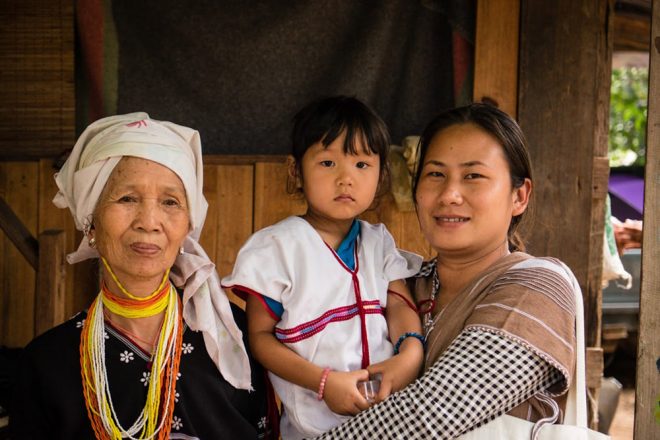
Siwakorn runs Lazy Man Coffee, a small business that works with families in Ban Nong Tao and neighboring villages to farm Arabica coffee using their indigenous forestry techniques. He then collects the coffee, processes it, and roasts it on-site. Needless to say, this is single-origin, ultra-micro lot coffee.
I asked Siwakorn if he has a message for people who’re interested in learning about Karen and other indigenous lifestyles: “When we drink water, we must take care of the water. We use the soil, we take care of the land. We use the air, we take care of the earth.”
Nongtao Homestay is a good option to stay in the village, but it’s also worth contacting Lazy Man Coffee directly to express your interest, explain why you want to come, and see what they recommend. As far as transportation, just ask ask Nongtao Homestay or any other contact in the village but renting a car or motorbike and driving up is probably the simplest option.
Note: If you can, stop for a meal at one of the restaurants sitting in the Mae Wang river on your way up, and watch mahouts (and people on package tours) washing and feeding some elephants. You can also take bamboo rafts with a guide or inner tubes (probably no guide, unless you buy them a beer) for a float down the river.
Mae Salong
The green tea plantations of Mae Salong run up from the Burmese border and across mountain sides that were once covered in opium fields. The town of Mae Salong is a Yunnanese settlement an hour-and-a-half drive from Chiang Rai and four hours from Chiang Mai. The road up into the hills alternates between rolling forests and tea plantations – bushy plants arranged in arching rows along the slopes. The temperature drops slightly and the air is lighter and clearer (except in smokey season, late February through April). Near the top of one of these green rises sits Mae Salong, a tea-fueled market town with a winding history and a diverse makeup.
Mae Salong was founded by members of the Kuomintang army, Chiang Kai-shek’s Chinese nationalists who fled the Chinese civil war and fighting with Mao Tse Tung’s forces in 1950. The Kuomintang fighters then spent the next decade moving between Myanmar’s Shan State, Thailand, and Yunnan province. In 1961, Thailand granted them asylum and gave them the land around Mae Salong. In exchange, they agreed to help fight the communist opposition inside Thailand for the next 20 years.
During this whole period, the area was also one of the biggest opium-producing regions in the world, much of it under the control of the drug lord Khun Sa. Sometime in the 1980s, the late Thai King Rama IX began working with the local communities to replace the opium trade with an economy based around tea. This interaction between King Rama IX and ethnic groups in the north is worth learning and asking about, especially the system of Royal Project initiatives.
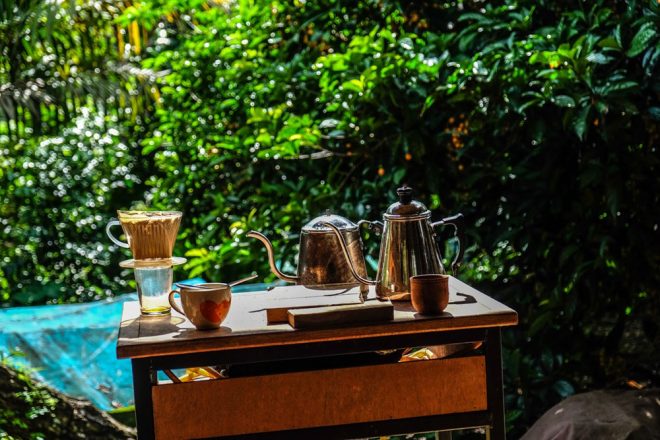
The most popular way to explore the tea plantations is through Tea 101 Factory and Plantation. They offer tours on a walk-in basis that give you a chance to learn about tea farming, tea processing, and the lifestyle of local communities around Mae Salong. Feel free to Facebook them in advance. Buying tea from here or any place in town on top of the hill seems like a great way to support the local tea industry and make sure your money goes straight into the community, but it’s still tough to know who’s benefiting from your baht.
Note: There are at least two Tea 101s in Mae Salong. You’re going for the one with the green and red sign.
To see another side of the Yunnanese culture of Mae Salong, stop at any of the restaurants near the main intersection in town. Look for fragrant, dark curries and yellow Yunnanese noodles. Lao Sang Phochana is a good bet. It’s across a side street from the school at the center of town, right by the Mae Salong 0 KM sign. There’s no English name on the place – เล่าซางโภชนา in Thai – but look for a long awning with a red sign with yellow letters. Go for the Chinese versions of Burmese salads, the stewed pork, and the steam buns.
But not everyone in Mae Salong is Yunnanese. Many of the surrounding villages are Akha, Lisu, and Lahu. It’s workers from these communities, at least as much as the Yunnanese, who work the tea plantations.
Akha Mud House is a guesthouse made of natural building materials in one of the Akha villages around Mae Salong. It’s run by Yohan, a leader in the village who’s made it his mission to create a space for travelers to come and experience life in his community. The structure is red clay and bamboo plastered with rice husks. Yohan is quick to say he’s not an architect, but the place is a feat of creative design. As of late 2018, they were building a new set of rooms that will have skylights. Revenue from the guesthouse goes back into projects that benefit the village.
Yohan and the staff know the area and can connect you with guides for trekking, maps and recommendations of experiences in the area. The coffee and the breakfast here are worth mentioning: drip brew and some of the best khao tom rice soup I’ve had, filled with dried mushrooms and herbs.
The simplest way to get to Mae Salong is to rent a motorbike in Chiang Mai or Chiang Rai and drive up on your own steam. You’ll be better off being able to get around the area without having to wait for rides, and Akha Mud House would be difficult to reach (but contact them and they could probably work something out).
Some links may be affiliate links, meaning I may earn commission from products or services I recommend. For more, see site policies.
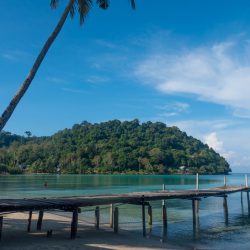
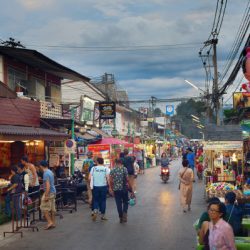




Awesome article. Thailand is growing in terms of tourism and this article can help the hill tribes get their deserved attention and business.
Cheers for this Article! I think responsible tourism is really important and I love all the photography you have included in this post!